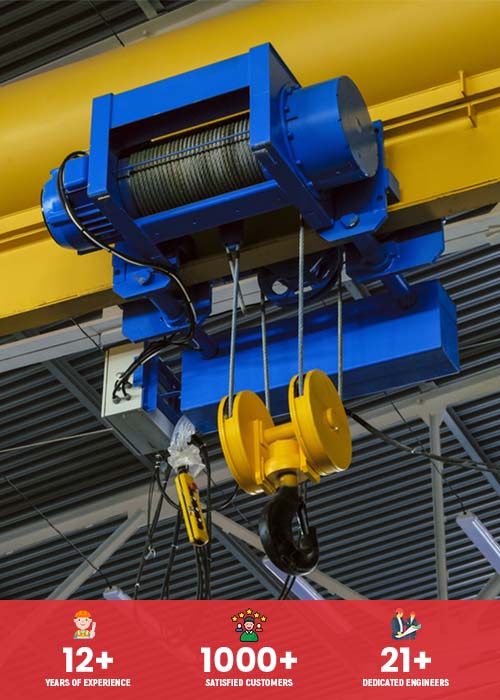How EOT Cranes Support Construction Projects Efficiently
If you’re in the construction industry, you already know how material handling can make or break a project. Lifting heavy beams, steel structures, concrete slabs, and machinery manually is not just time-consuming but also risky. That’s where EOT Cranes for construction sites come into play!
From high-rise buildings to bridges and industrial projects, these cranes provide safe, fast, and cost-effective overhead lifting solutions. Let’s explore how EOT Cranes are transforming construction projects across India!
Understanding EOT Cranes in Construction
What is an EOT Crane?
An Electric Overhead Travelling (EOT) Crane is a mechanized lifting system that moves along parallel runway beams to handle heavy loads. It is powered by electric motors and controlled manually, semi-automatically, or automatically.
Components of an EOT Crane:
✅ Bridge Structure 🏗️ – The mainframe that supports the crane.
✅ Hoist & Trolley 🏋️ – Lifts and moves materials horizontally.
✅ End Carriages 🚂 – Supports movement along the rails.
✅ Control Panel & Motors ⚙️ – Ensures smooth operation.
📊 Industry Insight:
According to reports, the Indian crane market is expected to grow at a CAGR of 7.5%, driven by the booming construction & infrastructure sector.
Key Benefits of EOT Cranes in Construction Projects
Investing in an EOT Crane for construction offers multiple advantages. Let’s take a look:
✅ High Load-Bearing Capacity 🏋️♂️
- Easily lifts materials weighing from 1 ton to 500 tons.
- Ideal for transporting steel beams, pre-cast slabs, and machinery.
✅ Faster & More Efficient Material Handling 🚀
- Reduces manual effort by 40-50%.
- Improves construction speed & reduces delays.
✅ Enhanced Safety & Risk Reduction 🚧
- Minimizes accidents caused by manual lifting.
- Comes with safety features like overload protection, emergency brakes & limit switches.
✅ Cost Savings 💰
- Reduces labour costs and material damage.
- Long-term investment with low maintenance requirements.
📊 Fact:
Construction companies that use EOT cranes report a 30-40% reduction in labour costs and 50% improvement in project timelines.
Types of EOT Cranes Used in Construction
Choosing the right overhead lifting solution depends on your project requirements. Here are the main types of EOT cranes for construction sites:
🛠️ Single Girder EOT Cranes
✔️ Suitable for small & medium-sized construction sites.
✔️ Lifting capacity up to 20 tons.
✔️ Budget-friendly & easy to maintain 💰.
🏗️ Double Girder EOT Cranes
✔️ Best for heavy-duty applications.
✔️ Lifting capacity up to 500 tons.
✔️ Provides better stability & higher lifting height.
🚧 Gantry EOT Cranes
✔️ Ideal for outdoor construction projects like bridges & metros.
✔️ Moves along ground rails instead of overhead beams.
✔️ Best for loading/unloading heavy materials at construction yards.
⚡ Semi-Gantry EOT Cranes
✔️ Space-saving design for sites with limited space.
✔️ One side is supported by ground rails, while the other runs on an overhead beam.
💡 Pro Tip: If you need high mobility for your project, go for a Gantry Crane. If you require heavy lifting inside a warehouse, choose a Double Girder EOT Crane.
How EOT Cranes Improve Efficiency in Construction
📌 Speeding Up the Construction Process ⏳
- Lifts and moves materials 5X faster than manual handling.
- Helps speed up high-rise & industrial building construction.
📌 Ensuring Workplace Safety & Reducing Accidents 🚦
- Comes with anti-collision technology, load sensors & emergency stop systems.
- Prevents falling object hazards & worker injuries.
📌 Reducing Construction Costs 💰
- Cuts labour dependency by up to 50%.
- Lowers material wastage & handling errors.
📊 Case Study:
A leading construction company in India switched to EOT Cranes for metro rail projects and saw a 35% increase in efficiency while reducing construction delays by 20%.
Applications of EOT Cranes in Construction
🏢 High-rise buildings – Lifting steel frames, scaffolding, and pre-fabricated sections.
🛣️ Bridges & flyovers – Moving heavy girders & concrete blocks.
🏗️ Industrial & commercial buildings – Handling construction machinery & raw materials.
🚆 Railway & metro projects – Transporting tracks, beams & infrastructure components.
📊 Construction Insight:
The demand for EOT Cranes in India has surged by 40% in the past five years, thanks to the growth of the real estate & infrastructure sectors.
Choosing the Right EOT Crane Manufacturer in India
🔍 Factors to Consider Before Buying an EOT Crane
🏅 Reputation & Experience 🏆 – Look for manufacturers with a strong track record.
⚙️ Customization Options 🎨 – Ensure they provide customized crane solutions.
🚦 Safety Standards & Compliance ⚠️ – Must meet IS 3177 & IS 807 Indian standards.
🛠️ After-Sales Support 🔧 – Warranty, maintenance & spare parts availability.
The Future of EOT Cranes in Indian Construction 🚀
The construction industry is evolving with new lifting technologies. Here’s what’s next:
🌐 IoT & Smart Automation – Remote-controlled cranes for real-time monitoring.
🔋 Energy-Efficient Cranes – Eco-friendly designs with low power consumption.
📡 AI-Powered Predictive Maintenance – Reduces downtime & repair costs.
📊 Industry Forecast:
By 2030, smart EOT Cranes will reduce project completion time by 50%, making Indian construction projects more efficient & cost-effective.
Conclusion
If you’re in the construction business, investing in an EOT Crane for construction is a smart move! It ensures faster operations, lower costs, and improved safety.
💡 Final Takeaways:
✅ Choose the right crane for your project needs.
✅ Invest in a reliable EOT crane manufacturer in India.
✅ Stay ahead with smart automation & latest crane technologies.📢 What’s your experience with EOT Cranes? Drop your thoughts in the comments 💬 below! 🚀



